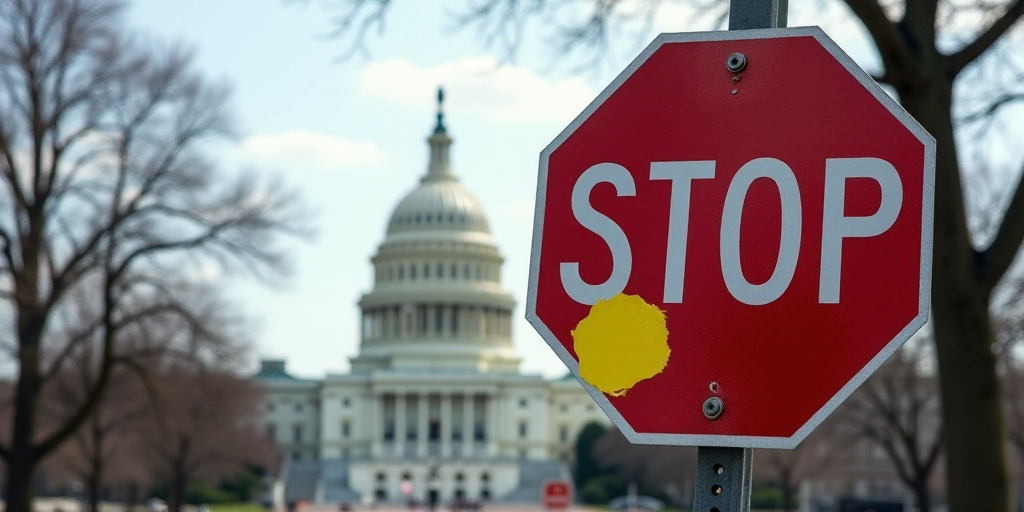Introduction
The United States entered a budget standstill on Wednesday, with a new vote in the Senate failing to resolve the situation. This development signals an intense conflict between President Donald Trump’s Republican party and the Democratic opposition.
Background on Budget Standstills
This marks the first standstill, or “shutdown,” since 2019, when the longest shutdown in history occurred for 35 days.
The Senate, where the final budget package must be approved to fund administrative spending until the end of November, did not approve the Republicans’ proposal again on Wednesday.
Senate Vote and Party Dynamics
President Trump’s party holds a majority of 53 seats out of 100 in the Senate, but they need seven more affirmative votes (up to 60) for a budget-related vote. Only three Democrats voted in favor, the same as the previous night.
The temporary spending extension proposal, extending funding until November 21st, has been stalled since the Republican-majority House of Representatives approved it by a narrow margin.
Impact on Government Operations
Hundreds of thousands of federal government employees from various departments and agencies stopped working or were forced to report for duty (especially those related to national security) without pay.
The White House tweeted that “Democrats shut down state services,” accompanied by a countdown of the shutdown’s duration.
Key federal agencies, such as NASA, were closed due to the lack of government funding. Some U.S. embassies announced on social media that they would only update information regarding urgent security matters.
National parks remained open, but cleaning and surveillance services were not guaranteed. Americans could still receive retirement, unemployment checks, and mail.
Congressional Democratic leaders, Senate Minority Leader Chuck Schumer and Representative Hakeem Jeffries, stated in a joint statement that “Donald Trump and the Republicans shut down state services because they refuse to protect American healthcare.”
Vice President JD Vance expressed willingness to negotiate with Democrats, but only after “restarting state operations.”
Republican and Democratic Budget Goals
Republicans aim to extend current funding and negotiate a long-term spending plan.
Democrats, however, want to restore hundreds of millions of dollars in healthcare spending, particularly in the low-income family health insurance program known as “Obamacare.”
Economic Impact
Republicans accuse Democrats of wanting to maintain healthcare spending levels from the COVID-19 pandemic era and hiding basic care services for illegal immigrants within this massive public spending portion.
Upon the standstill’s commencement, the White House Budget Office Director Russell Vought ordered federal agencies to implement an “orderly shutdown” in a letter.
According to the Congressional Budget Office (CBO), 750,000 federal employees are affected.
Nationwide insurance analysts estimate that each week of the shutdown could reduce U.S. GDP growth by 0.2 percentage points.
The previous shutdown during Trump’s first term lasted 35 days, reducing the GDP by an estimated $11 billion, according to CBO calculations.
Since 1976, the federal government has partially closed 21 times under this modern congressional budget process.
Key Questions and Answers
- What is a budget standstill or shutdown? A budget standstill, or government shutdown, occurs when Congress fails to pass appropriations bills or continuing resolutions, temporarily halting non-essential government services.
- Which agencies and services were suspended? Many federal agencies, including NASA, experienced closures. National parks remained open but lacked cleaning and surveillance services. Federal employees in non-essential roles were furloughed without pay.
- What are the goals of both parties? Republicans aim to extend current funding and negotiate a long-term spending plan. Democrats want to restore healthcare spending, particularly in low-income family health insurance programs like “Obamacare.”
- What is the potential economic impact? Analysts estimate that each week of a shutdown could reduce U.S. GDP growth by 0.2 percentage points. The previous longest shutdown, during Trump’s first term, reduced the GDP by an estimated $11 billion.






